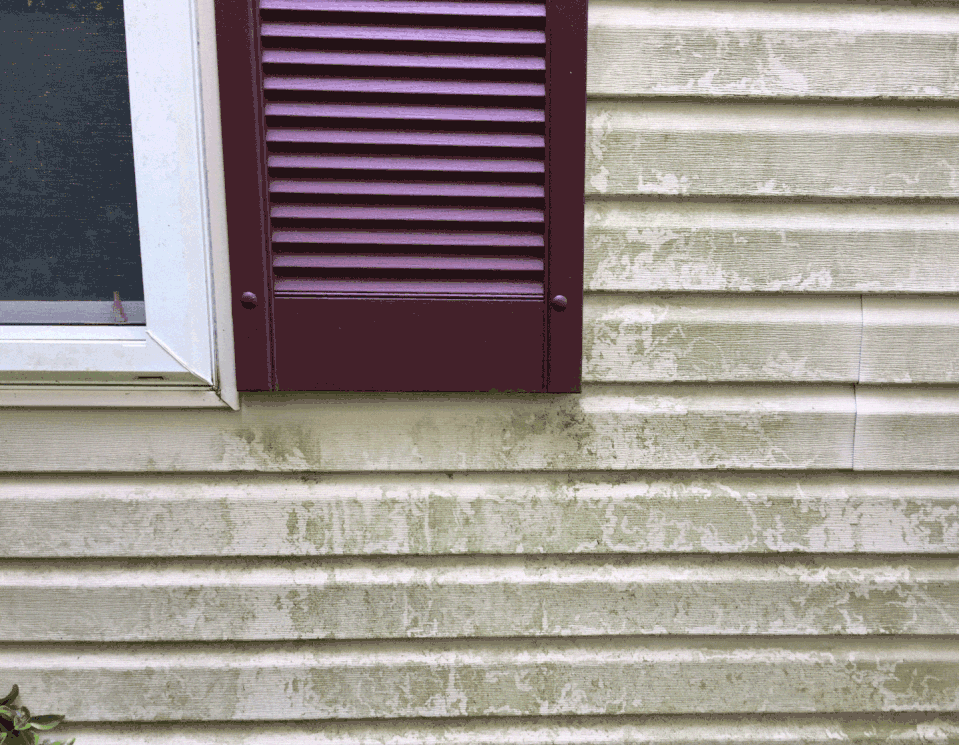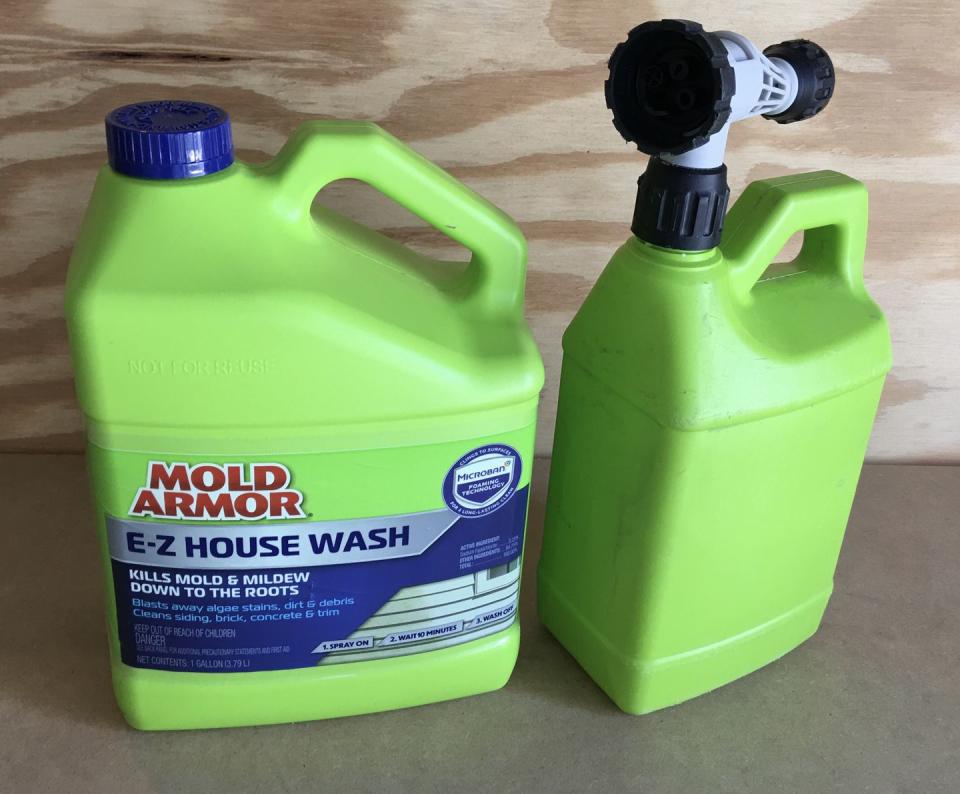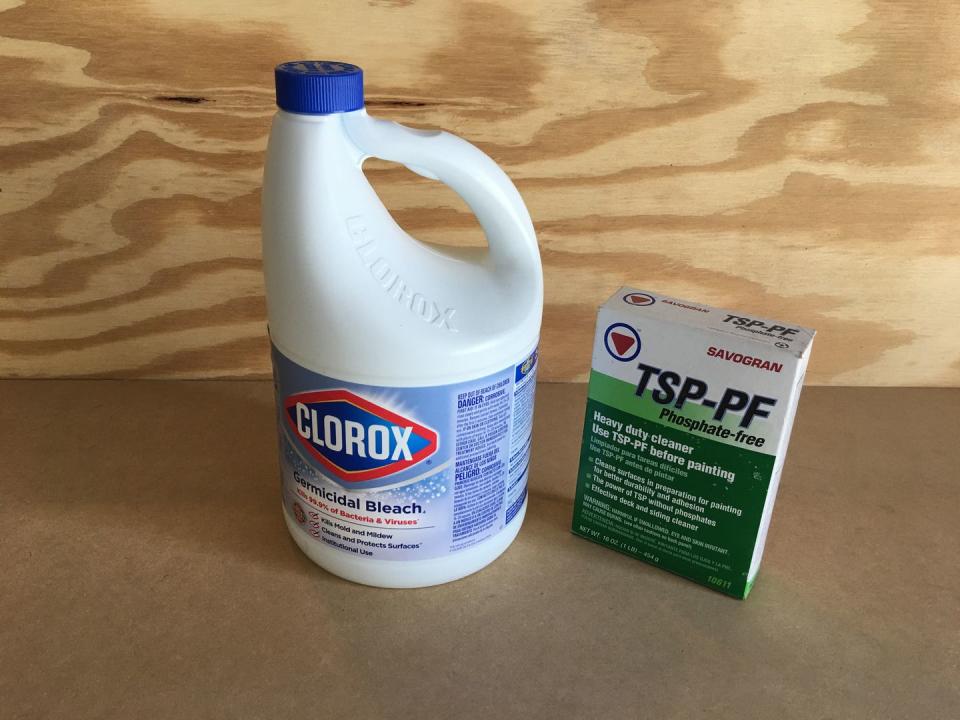How to Remove Summer Mildew

"Hearst Magazines and Yahoo may earn commission or revenue on some items through these links."
Mildew (a form of mold fungi) is an unfortunate byproduct of summer. Fortunately, simple cleaners and cleaning methods easily remove this growth from siding, window trim, pavements, and exterior furnishings.
And the equipment you need to deal with it is also pretty simple: a garden hose and nozzle, bucket, a soft scrub brush suitable for siding, a garden sprayer, and some form of an extension handle puts tall areas easily within reach—sometimes you don’t event have to get up on a ladder. Add a small pressure washer to the cleaning arsenal if you plan to wash the entire house or clean, say, a concrete driveway, patio or walkway.
You can either buy premixed cleaners or you can mix your own using materials available at any home center or paint store.
We show everything you need below.

Start Simple
In the simplest terms, there are two types of mildew-removing cleaners: home-brewed and store bought.
My preferred store-bought cleaner is Mold Armor because it contains Microban, an additive that inhibits fungi formation after the surface has been cleaned. Thus, the surface stays cleaner longer. I typically go through a gallon of this a year and sometimes two if the conditions have been particularly damp and fungi forming. If I’m using my pressure washer, I add the pressure washer concentrate to the machine’s tank.

The advantage of applying store bought cleaner is that it’s simple. Shake up the applicator container and hook it up to your garden hose. In the case of pressure washers, pour the concentrate into the machine’s tank. The applicator has a nozzle that adjusts the stream to apply the cleaner. Rotate the nozzle to the appropriate positions; one is for application and another is for rinsing. When you use up the cleaner in the applicator, just buy another gallon and refill the applicator with that, rather than buying a new applicator.
But if Mold Armor is out of stock, I mix my own cleaner, using one or another variation of the recipes that you see here.
For light-duty cleaning, use this formula at the Clorox website, adjusting its strength to suit the amount of mildew on the surface. The recipe calls for 1/3 cup liquid disinfecting (regular) bleach to 5 gallons of water. For heavy-duty cleaning, increase the concentration to as much as 1 cup of bleach to 3 gallons of water.
However if there is grimy surface dirt on the siding, grass clippings, or air pollution residue, you need more dirt-loosening chemical power, because often fungi and surface dirt are bonded together and tough to remove. That’s when I turn to this formula, right off the box of TSP-PF: 1/2 cup TSP-PF dissolved in 3 quarts of warm water and 1 quart liquid bleach.

This is a high-strength cleaner. If possible, test it on an inconspicuous surface before cleaning the entire area. It cleans so effectively, it may change the color or appearance of siding and trim, removing dirt, mildew and oxidized paint. This may also cause the paint itself to work loose if it’s loosely bonded and weak. That’s why painting contractors sometimes use this cleaner (or a cleaner like it) prior to or in conjunction with power washing. That’s a formidable paint preparation regimen: strip off mold and dirt chemically and use high-pressure water to blast the surface completely clean.
And protect yourself, too. Wear safety glasses or goggles when pressure washing and when applying these cleaners. Wear rubber gloves when mixing.
Pressure Washing
As effective as pressure washers are at cleaning siding, you don’t need one if all you need to do is remove a section of siding with mildew on it and a relatively light accumulation of dirt.
But let’s say you’ve got a lot of siding, deck, furnishings, fence, and pavements to clean. Then it makes sense to own a light-duty electric pressure washer. Many users find that a small electric pressure washer rated somewhere in the range of 2100 to 2400 psi is more than enough machine for their cleaning purposes, plus it doesn’t take up a lot of space in the garage or shed.
A caveat here with these light-duty electrics (and light-duty gas engine machines): don’t expect to blast clean the siding of a really tall house with them. You’re going to either need to go up a ladder, use a really long extension pole with a scrub brush or use some combinations of tools and methods to clean tall siding.
Getting It Clean
Before you step out the door to have at it, there are a few more things you need to know.
Wash from the bottom up and rinse slowly, thoroughly, and gently from the top down.
Protect shrubs and delicate plantings when using powerful mildew-removing cleaners. The chemicals in these cleaners can easily damage plant tissue. Use a garden hose and nozzle to thoroughly dampen plants in the vicinity. Cover delicate plants with plastic tarps if necessary.
Protect your skin. Wear an old long-sleeve shirt to protect your arms. It’s impossible to avoid splash back when cleaning. Powerful exterior cleaners will irritate your skin, so rinse your hands, arms, face, and neck as soon as possible.
Wear rubber gloves when scrubbing and mixing.
Runoff from the siding will streak nearby glass surfaces. Rinse these surfaces thoroughly with clear water after washing the surrounding siding and trim, but don’t pressure wash glass (it can ruin the seal on insulated glass windows). After any thorough cleaning, you may need to go back and gently wash the glass to remove streaks from it. It’s chemically safest to use an ammonia-free dedicated glass cleaner. If you do use an ammonia-based glass cleaner, use it only after all bleach-based cleaners have been removed from the vicinity and the area has been thoroughly rinsed. Mixing bleach-based cleaners with ammonia creates harmful fumes.
You Might Also Like

